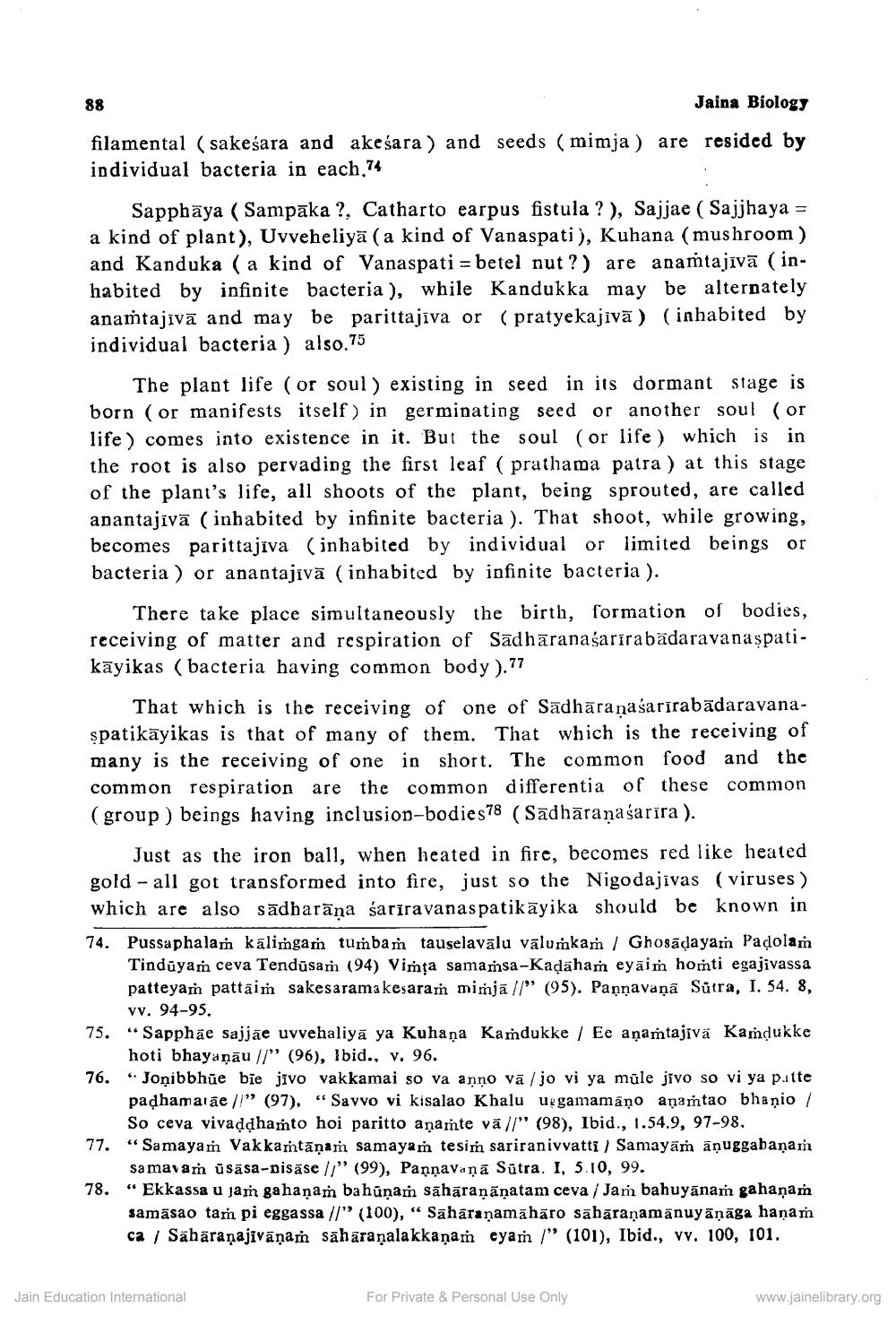________________
88
Jaina Biology
filamental (sakesara and akeśara) and seeds (mimja) are resided by individual bacteria in each.74
Sapphāya (Sampaka ?, Catharto earpus fistula ? ), Sajjae ( Sajjhaya = a kind of plant), Uvveheliyā (a kind of Vanaspati), Kuhana (mushroom) and Kanduka (a kind of Vanaspati = betel nut?) are anamtajīvā (inhabited by infinite bacteria), while Kandukka may be alternately anamtajivā and may be parittajīva or (pratyekajīvā ) (inhabited by individual bacteria ) also.75
The plant life (or soul) existing in seed in its dormant stage is born (or manifests itself) in germinating seed or another soul (or life) comes into existence in it. But the soul (or life ) which is in the root is also pervading the first leaf (prathama patra) at this stage of the plant's life, all shoots of the plant, being sprouted, are called anantajīvā (inhabited by infinite bacteria ). That shoot, while growing, becomes parittajiva (inhabited by individual or limited beings or bacteria ) or anantajivā ( inhabited by infinite bacteria).
There take place simultaneously the birth, formation of bodies, receiving of matter and respiration of Sadhāranaśarīrabädaravanaspatikāyikas (bacteria having common body ).77
That which is the receiving of one of Sadhāranaśarīrabādaravanaspatikāyikas is that of many of them. That which is the receiving of many is the receiving of one in short. The common food and the common respiration are the common differentia of these common (group) beings having inclusion-bodies78 (Sadhāranasarira).
Just as the iron ball, when heated in fire, becomes red like heated gold - all got transformed into fire, just so the Nigodajivas (viruses ) which are also sādharāna sarīravanas patikāyika should be known in 74. Pussaphalam kalimgam tumbam tauselavālu vālumkam / Ghosādayam Padola
Tindűyam ceva Tendūsam (94) Vimța samamsa-Kadāham eyain homti egajivassa patteyam pattaim sakesaramakesaraṁ mimjā //” (95). Pannavaņā Sūtra, I. 54. 8,
vv. 94-95. 75. “Sapphãe sajjāe uvvehaliyā ya Kuhana Kamdukke / Ee anamtajivá Kamukke
hoti bhayaņāu //" (96), Ibid., v. 96. 76. "Joņibbhūe bie jivo vakkamai so va anno vā / jo vi ya mūle jivo so vi ya pitte
padhamalae /!" (97), "Savvo vi kisalao Khalu uagamamāņo anamtao bhaņio /
So ceva vivaddhanto hoi paritto anamte vā//" (98), Ibid., 1.54.9, 97-98. 77. "Samayam Vakkamtāņam samayam tesim sariranivvatti / Samayām āņuggabaņam
samavam ūsāsa-pisāse //" (99), Pannavaņā Sūtra. I, 5.10, 99. 78. "Ekkassa u jam gahaņam bahūņam sahāraņāņatam ceva / Jam bahuyānam gahanam
samāsao tam pi eggassa //" (100), “ Saharanamāhāro sahāraṇamānuyāṇāga hanam ca / Sähāraṇajivāņam sāharaṇalakkaņam eyam /" (101), Ibid., vy. 100, 101.
Jain Education International
For Private & Personal Use Only
www.jainelibrary.org




